Remembering the fun of making games at the 2015 Apple ][ Reunion Party
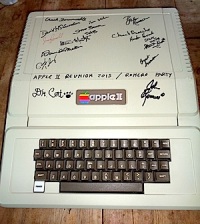 For this week’s blog post I had planned to write about my experiences at E3, the Electronic Entertainment Expo, but then I received an invitation to attend an even more noteworthy event — a reunion at the home of Doom developer John Romero for many of us who had developed games for the Apple II computer. In addition to being a historic figure in game development himself, John has a deep love for the history of Apple II games. John’s first published game, Scout Search, appeared in the June 1984 issue of inCider, a popular Apple II magazine during the 1980s, and he went on to develop a number of Apple II games, both through his own company, and later, at Origin Systems. And while he has since gone on bigger and better things (did I mention that was one of the developers of Doom?), he is an avid collector of Apple II games, hardware and memorabilia.
For this week’s blog post I had planned to write about my experiences at E3, the Electronic Entertainment Expo, but then I received an invitation to attend an even more noteworthy event — a reunion at the home of Doom developer John Romero for many of us who had developed games for the Apple II computer. In addition to being a historic figure in game development himself, John has a deep love for the history of Apple II games. John’s first published game, Scout Search, appeared in the June 1984 issue of inCider, a popular Apple II magazine during the 1980s, and he went on to develop a number of Apple II games, both through his own company, and later, at Origin Systems. And while he has since gone on bigger and better things (did I mention that was one of the developers of Doom?), he is an avid collector of Apple II games, hardware and memorabilia.
My own introduction to the Apple II was through Gene Sprouse, one of my instructors at Cal State University, Northridge. I was enrolled in his COBOL business programming course, but when he found that I was using the university’s computer to print out pictures of the starship Enterprise, he asked me to stay after class. But instead of criticizing me for wasting valuable computer time, he offered me a job. Gene and several other partners owned Rainbow Computing, the second computer store to open in Los Angeles, and wanted me to work as a clerk in his store. Of course, I happily accepted.
Not long after I started working at Rainbow Computing, Gene and his main partner, Glenn Dollar, became registered dealers of a new computer called the Apple II. Prior to this time, computers were sold to hobbyists, because they had to be assembled and were difficult to use. However, the Apple II, created by engineer Steve Wozniak and his business partner, Steve Jobs, was designed for home use. It could be connected to the family’s home television set and came with game paddles.
However, there wasn’t much software (what the kids these days would call “apps”) available for it when it game out, not even games. But the machine did come with its own, easy-to-use, programming language, BASIC. So, what a lot of our customers would do after purchasing an Apple II was to program their own software. Then, they might make some copies of it (on standard audio cassette tape), photocopy some documentation, put everything into a ziplock bag, and then bring it to our store to sell. We eventually received such an inventory of games and other software to sell that we opened up a mail-order business, and filling those orders became my responsibility.
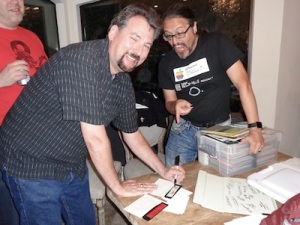 John asks me to sign his copies of The Prisoner and Prisoner 2. John asks me to sign his copies of The Prisoner and Prisoner 2. |
Some of our customers also decided to start their own game companies — Ken Williams of Sierra Online, Dave Gordon of Programma International, and Sherwin Steffin of Edu-Ware Services. Upon learning that I was studying computer science and had an interest in games, Sherwin asked me if I would write some games for his company. So, while I was finishing up my degree, I created Space II (a text-based RPG), Windfall (an oil crisis simulation), and Network (a television programming experience) for Edu-Ware, before joining the company full-time when I graduated. During my time at Edu-Ware, I programmed my most well-known Apple II games, the text-based adventure The Prisoner, and its hi-res graphics update, Prisoner 2.
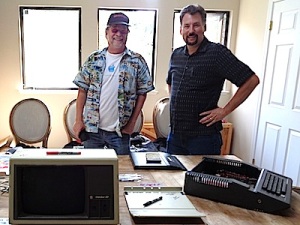 Looking over the Apple II hardware partygoers brought to be signed, with Softape co-founder Gary Koffler Looking over the Apple II hardware partygoers brought to be signed, with Softape co-founder Gary Koffler |
Another major software publisher of this early era was Softape. Co-founded by William Smith, Bill Depew and Gary Koffler, The company published computer games, utilities and productivity programs for the Apple II family. Softape produced a newsletter magazine Softalk, but it was taken over by Margot Comstock and Al Tommervik in 1980 and re-designed into the Apple II enthusiast magazine Softalk. The startup capital for Softalk came money Margot had won on the television game show Password. Margot told host Allen Ludden that she wanted to use her winnings to buy a computer, and after several trips to various computer stores, she settled on the Apple II.
 With Softalk founders Margot Comstock and Al Tommervick. With Softalk founders Margot Comstock and Al Tommervick. |
It is impossible to overstate the influence Softalk had in forging a community out of all these “mom-and-pop” companies started by devotees of the Apple II. Unlike other computer magazines that generally focused on a specific, narrow subject matter or market segment, Softalk gave broad coverage to all parts of the Apple world of the time, from programming tips to game playing, from business to home use, including computing as an industry, a hobby, a tool, a toy, and a culture.
 With Assembly Lines author, Scott Wagner. With Assembly Lines author, Scott Wagner. |
Another characteristic of the magazine was a playful, insider-like voice. The experts in those early days seemed to chat in their own relaxed language about the techniques and elements of their world. One of these experts was Roger Wagner, who wrote a column (and eventually a book) on programming in assembly language for the Apple II. I probably learned more about sophisticated programming from Roger than I did in college, allowing me to program graphics engines, natural language parsers, and maze generators for my games in the Apple’s 6502 assembly language.
Eventually, I went on to form my own game publishing company, Electric Transit in 1985. We specialized in real-time 3D simulations games for the Apple II (and the IBM PC). Because games were still being sold through thousands of individual mom-and-pop retailers throughout the country, and, so we needed a distributor to get our product to those retailers. We turned to another young company that had started just a couple of years before us, Electronic Arts, and we became their first affiliated label software publisher. Unfortunately, being the first, EA made a lot of initial mistakes with us, such as overestimating orders of our product, and within two years, we were out of business.
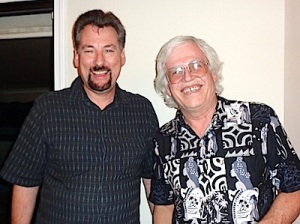 With Dick Tracy programmer, Steve Baker. With Dick Tracy programmer, Steve Baker. |
I then joined The Walt Disney Company in 1987 as its very first game producer. I produced a number of games for the Apple II (as well as other platforms) at Disney, and my last Apple II game was based on the film Dick Tracy. Programmed by Steve Baker, it was one of the most technically sophisticated Apple games I ever produced, thanks to Steve’s audio routines, but two months before it was complete, our marketing department determined that the market for Apple II games had died out and requested the project to be cancelled.
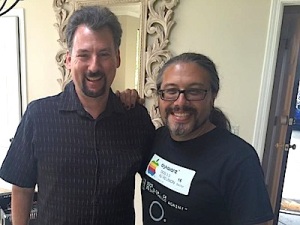 With our gracious host, John Romero. With our gracious host, John Romero. |
Flash forward 10 years: John Romero holds a party at his company Ion Storm for a reunion of Apple II game developers. When I received the invitation, nothing could stop me from hopping on a plane to Dallas. There I met some of the people that produced some of my favorite Apple II games, including Dan Gorlin of Choplifter fame.
Flash forward another 15 years, to last week. While I’m preparing for E3, I receive a Facebook message from Softape co-founder Gary Koffler that John was holding another reunion party at his home in the Santa Cruz area that weekend. It took surprisingly little effort to convince my wife, Char, to make the five-and-a-half hour drive up to attend the party (it helps that we decided to spend the night at a hotel along the beach.
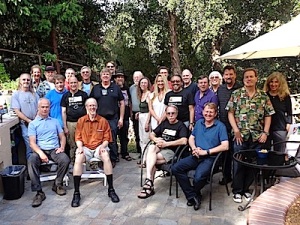 Partygoers in the Casa Romero backyard. Partygoers in the Casa Romero backyard. |
We arrived a couple of hours late, and the party is in full force. John and his wife, Brenda, have a lovely home in the forested area. Too my delight, I see the house is decorated with items from John’s games and games in general. But best of all were the terrific people who showed up. In addition to the ones pictured above, here are some of the people I had the pleasure of seeing again (some, after a decade or two) or whom I have long admired but never had a chance to meet before.
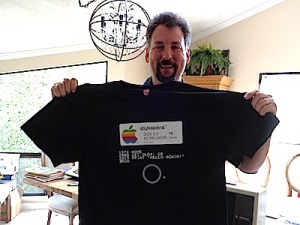 2015 Apple ][ Reunion t-shirt. 2015 Apple ][ Reunion t-shirt. |
Af about 11pm, Char and I started to nod off, so we had to take our leave. John was nice enough to make t-shirts for us to remember the event. It was sad to go, but I hear that John is already planning another of these reunions, one with hopefully even more of us Apple II veterans in attendance.
Posted on June 22, 2015, in Game History, My Career and tagged EduWare, influences, The Prisoner. Bookmark the permalink. 1 Comment.



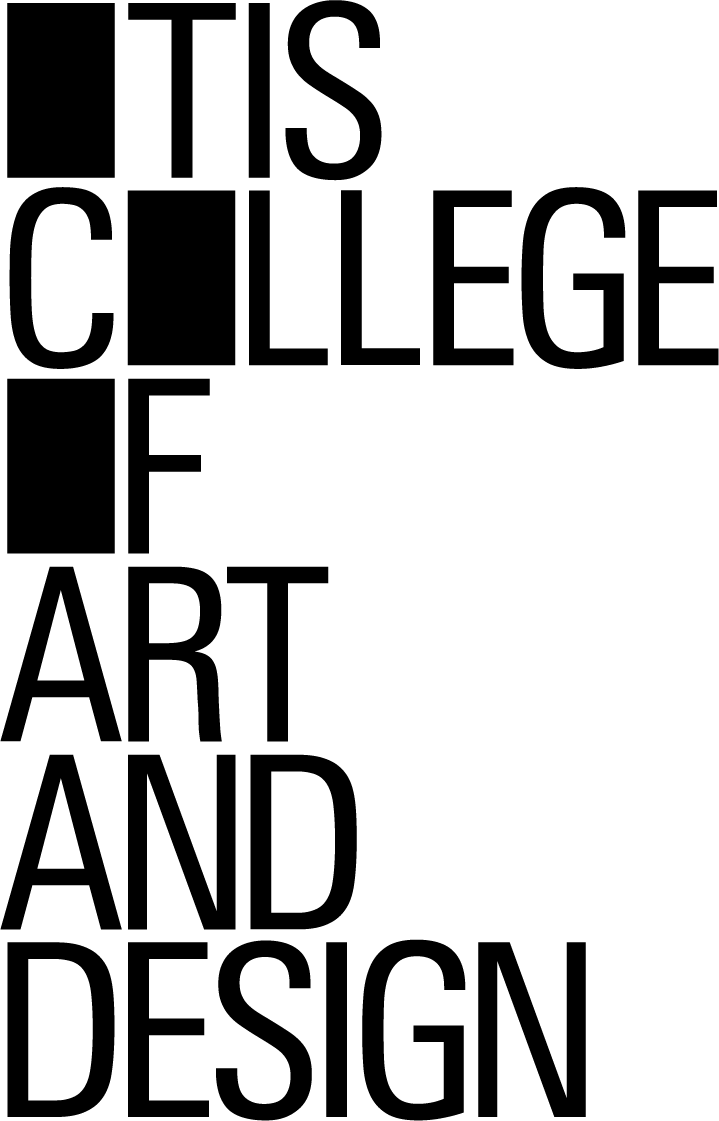

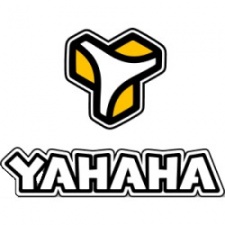
Pingback: The legend of John Romero | Apple II Bits